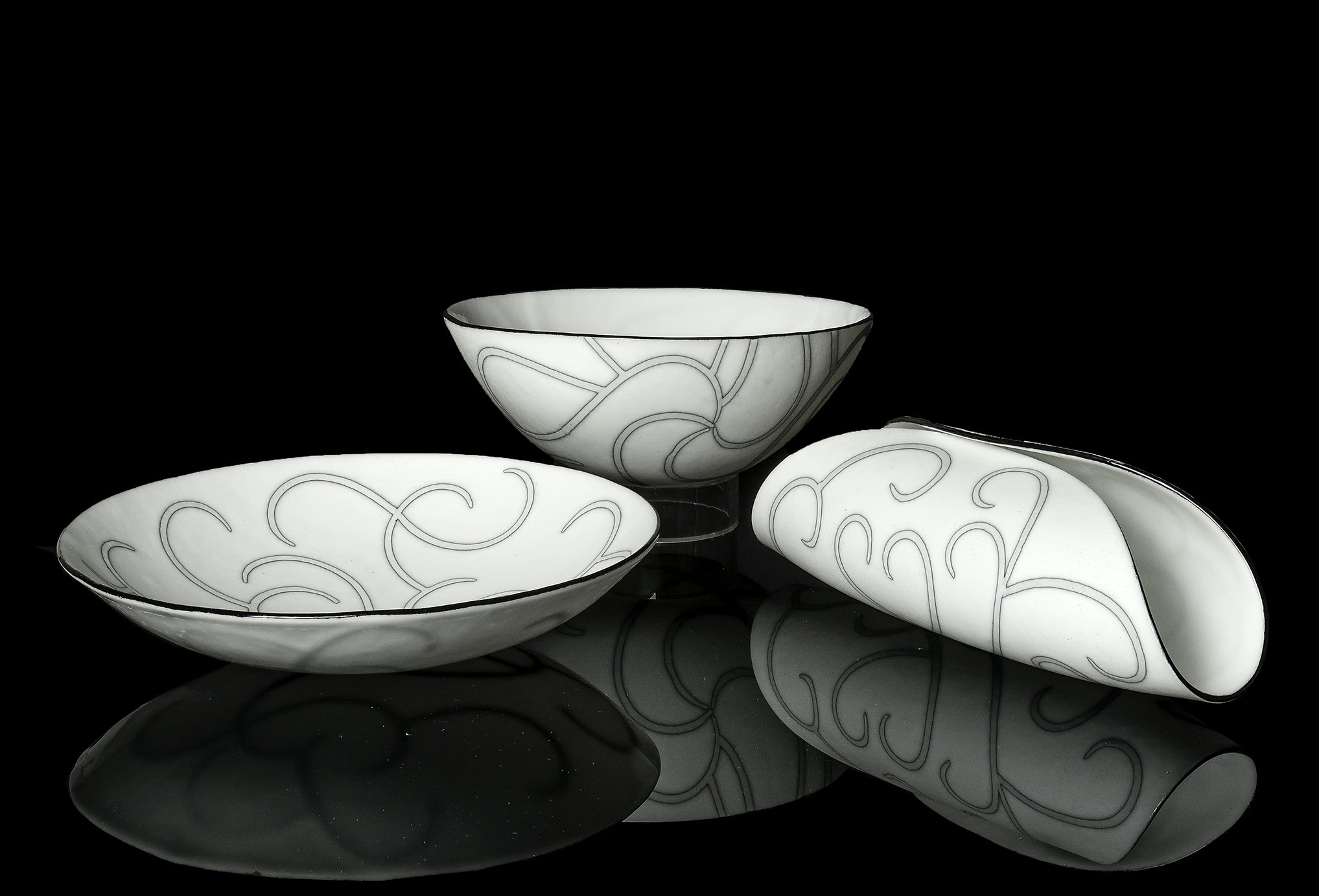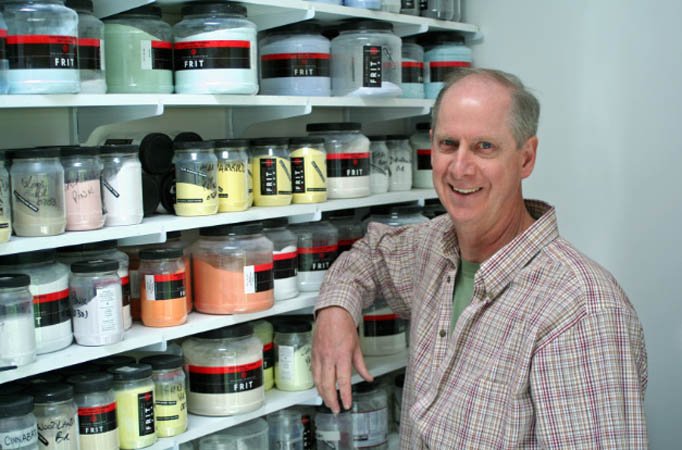 Image 1 of 9
Image 1 of 9

 Image 2 of 9
Image 2 of 9

 Image 3 of 9
Image 3 of 9

 Image 4 of 9
Image 4 of 9

 Image 5 of 9
Image 5 of 9

 Image 6 of 9
Image 6 of 9

 Image 7 of 9
Image 7 of 9

 Image 8 of 9
Image 8 of 9

 Image 9 of 9
Image 9 of 9










Bob Leatherbarrow: Fine Line Designs
Register Here
DEC 6 - 8, 2025 ◆ Saturday - Monday ◆ 10:00AM - 5:00PM
3 days. 10 students maximum. Local Austin eateries catered lunches included!
Lines are a powerful design element. They separate regions within, and guide your eye around, a composition. Yet creating crisp, clean and controlled lines has been a challenge for artists working with kilnformed glass. Learn six ways to create intricate, precise and predictable patterns of straight, elegantly curved, or gestural lines. Discover how to make these lines join, intersect and branch seamlessly. Create fine coloured edges along the rim of slumped pieces that accentuate the shape of the bowl. Techniques outlined in this workshop can be incorporated into your favourite style to improve the composition and design of your piece.
This is a LIVE FROM AFAR class.
Each session will consist of discussions, demonstrations, and exercises in the Helios Studio that Bob will oversee and provide individual guidance from his home studio in Canada. Bob will be present and interacting with you individually the entire day while you work! Each student will also have a personal device connecting Bob to their station so he can follow you individually as you work, providing guidance and tips in real time.
More About Bob Leatherbarrow
(from www.https://www.leatherbarrowglass.com/)
My kiln-formed glass bowls, shields, sculptures, and roll-ups explore the subtle colours and delicate beauty of naturally occurring textures and encourage the viewer to ponder their origin.
Textures are a key part of our everyday visual landscape and through them we interpret how objects were formed, or how they evolved. Although textures may have common forms, their origin and evolution might be very different. For example, mud cracks in rocks and the wrinkled skin of the elderly look the same but are formed by entirely different processes. So by recognizing and interpreting textures we can understand and appreciate the stories of how objects and people evolve.
Stories have different interpretations depending on the timing and vantage points of our observations. I have tried to capture this sense of reference by presenting varying degrees of detail in my glass, from veining and blends of colours, to the use of delicate visual components. Thus, my pieces reveal one set of details when viewed from a distance and another set of details that are apparent only when viewed up close.
Register Here
DEC 6 - 8, 2025 ◆ Saturday - Monday ◆ 10:00AM - 5:00PM
3 days. 10 students maximum. Local Austin eateries catered lunches included!
Lines are a powerful design element. They separate regions within, and guide your eye around, a composition. Yet creating crisp, clean and controlled lines has been a challenge for artists working with kilnformed glass. Learn six ways to create intricate, precise and predictable patterns of straight, elegantly curved, or gestural lines. Discover how to make these lines join, intersect and branch seamlessly. Create fine coloured edges along the rim of slumped pieces that accentuate the shape of the bowl. Techniques outlined in this workshop can be incorporated into your favourite style to improve the composition and design of your piece.
This is a LIVE FROM AFAR class.
Each session will consist of discussions, demonstrations, and exercises in the Helios Studio that Bob will oversee and provide individual guidance from his home studio in Canada. Bob will be present and interacting with you individually the entire day while you work! Each student will also have a personal device connecting Bob to their station so he can follow you individually as you work, providing guidance and tips in real time.
More About Bob Leatherbarrow
(from www.https://www.leatherbarrowglass.com/)
My kiln-formed glass bowls, shields, sculptures, and roll-ups explore the subtle colours and delicate beauty of naturally occurring textures and encourage the viewer to ponder their origin.
Textures are a key part of our everyday visual landscape and through them we interpret how objects were formed, or how they evolved. Although textures may have common forms, their origin and evolution might be very different. For example, mud cracks in rocks and the wrinkled skin of the elderly look the same but are formed by entirely different processes. So by recognizing and interpreting textures we can understand and appreciate the stories of how objects and people evolve.
Stories have different interpretations depending on the timing and vantage points of our observations. I have tried to capture this sense of reference by presenting varying degrees of detail in my glass, from veining and blends of colours, to the use of delicate visual components. Thus, my pieces reveal one set of details when viewed from a distance and another set of details that are apparent only when viewed up close.
Register Here
DEC 6 - 8, 2025 ◆ Saturday - Monday ◆ 10:00AM - 5:00PM
3 days. 10 students maximum. Local Austin eateries catered lunches included!
Lines are a powerful design element. They separate regions within, and guide your eye around, a composition. Yet creating crisp, clean and controlled lines has been a challenge for artists working with kilnformed glass. Learn six ways to create intricate, precise and predictable patterns of straight, elegantly curved, or gestural lines. Discover how to make these lines join, intersect and branch seamlessly. Create fine coloured edges along the rim of slumped pieces that accentuate the shape of the bowl. Techniques outlined in this workshop can be incorporated into your favourite style to improve the composition and design of your piece.
This is a LIVE FROM AFAR class.
Each session will consist of discussions, demonstrations, and exercises in the Helios Studio that Bob will oversee and provide individual guidance from his home studio in Canada. Bob will be present and interacting with you individually the entire day while you work! Each student will also have a personal device connecting Bob to their station so he can follow you individually as you work, providing guidance and tips in real time.
More About Bob Leatherbarrow
(from www.https://www.leatherbarrowglass.com/)
My kiln-formed glass bowls, shields, sculptures, and roll-ups explore the subtle colours and delicate beauty of naturally occurring textures and encourage the viewer to ponder their origin.
Textures are a key part of our everyday visual landscape and through them we interpret how objects were formed, or how they evolved. Although textures may have common forms, their origin and evolution might be very different. For example, mud cracks in rocks and the wrinkled skin of the elderly look the same but are formed by entirely different processes. So by recognizing and interpreting textures we can understand and appreciate the stories of how objects and people evolve.
Stories have different interpretations depending on the timing and vantage points of our observations. I have tried to capture this sense of reference by presenting varying degrees of detail in my glass, from veining and blends of colours, to the use of delicate visual components. Thus, my pieces reveal one set of details when viewed from a distance and another set of details that are apparent only when viewed up close.











